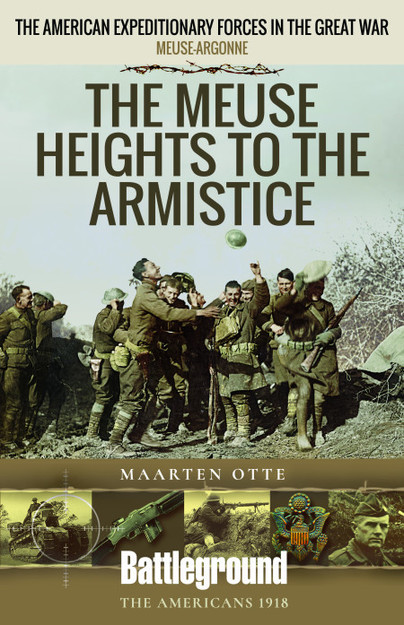

Hey Folks, welcome to the Battles of the First World War Podcast.
So, in preparation for the next podcast episode I’ve been reading Maarten Otte’s latest work of battlefield history and tourism: “The Meuse-Argonne 1918: The Right Bank to the Armistice.” For anyone interested in the Meuse-Argonne campaign on the Meuse Heights, and specifically on the right bank of the River Meuse, Maarten’s newest book will be an invaluable addition to your collection.
Full disclosure: I was given an advance copy of the copy by the publisher, Pen & Sword, in agreement for writing a review of the book.
If you have ever done a deep dive into the Meuse-Argonne campaign of the First World War and have ever traveled to the region, the name Maarten Otte will inevitably come up. Maarten and his wife Didi run 14-18 Meuse-Argonne, a small bed and breakfast and local museum located at 5 Rue de l’Argonne in Montfaucon d’Argonne. Maarten is a deeply-knowledgeable historian of the WW1 fighting in the Meuse region from end to end, and he regularly takes his hotel guests on day trips out to various points of the battlefield. In between working on his museum displays and tour-guiding, he has written thoroughly-researched battlefield guides that provide a wealth of information for the reader.
I have yet to walk the battlefields with Maarten as my guide. I did, however, have the pleasure of walking with him and several others from the Small Pocket at l’Homme Mort through the Argonne Forest to the Lost Battalion Pocket in November of 2021. Maarten is a cool dude, Folks. I look forward to having him come on the podcast soon.
“The Right Bank to the Armistice” is the fifth of Maarten Otte’s works, and is the latest in a deeper focus on the American offensive in the Meuse in the last months of WW1. This book covers the operations on the Right Bank of the Meuse, from the first day on October 8th, 1918 through the armistice that took effect on the 11th of November, 1918.
Maarten’s introduction provides the thesis for his latest work: that quote “the dominance of the German artillery on the Heights and the failure to allow for that dominance was a–if not the–crucial factor in holding up the whole offensive” end quote. The author argues that operations on the Right Bank of the Meuse should have occurred simultaneously with those west of the river, and he recognizes that many of the errors that were made in the planning and conduct of the Meuse-Argonne Offensive were quote “the inevitable consequence of a young army” end quote. He also argues that AEF leadership routinely underestimated German strength, and provides an example in that AEF 1st Army expected the French 17th Corps to clear the Meuse Heights across the river in just three days. (Parentheses: This, after they had planned to advance sixteen kilometers on the offensive’s first day and had come nowhere near that since then.) To back up these claims, Maarten provides a list of consequences the Americans endured from not clearing the Right Bank of German guns.
The book opens with a chapter dedicated to an overview of the AEF in the Meuse. The various phases of the American offensive are described in some detail, and Maarten provides three phases for the entire campaign: the first phase running from 26th-30th September, 1918, the second running October 1st through the 31st, and the third phase covering November 1st through the 11th.
Along with the overview are the difficulties the Doughboys faced in their operations. These were, as follows:
Quote
“The increasing resistance put up by the Germans,”
“The congestion of the roads and poor planning,”
“Inexperience and lack of sufficient and relevant training of the American soldiers,”
and that
“Artillery played a vital role in the German defensive strategy”
End quote
Chapters 2, 3, and 4 are where the reader will go deep. Chapter 2 covers the actions of the American 33rd, 29th, and 26th Divisions as they crossed the river and began to assault the Meuse Heights, from the dates of September 26th through the 31st of October. Chapter 2 sees the 33rd Division’s actions on the west bank of the Meuse in the opening days of the Meuse offensive, and then its assault across the river on the 8th. After that the reader sees the actions of the 29th, and then the 26th Divisions broken down.
Chapter 3 covers the operations of the 79th, the 26th, and the 32nd Divisions from the period between the 3rd and the 11th of November. Chapter 4 is dedicated solely to the 5th Division for the same period of the 3rd through the 11th of November.
The chapters are broken up first by division, and from there to day-by-day operations or multi-day status when things were quieter on the front. Each chapter features several relevant photographs, many taken by the author himself. Photographs of various commanders and noted soldiers are also found, and if a soldier is quoted in the text there is generally a picture so the reader can put the face to the words. This is a generally thoughtful approach. Many of the maps are sections of the American Battle Monuments Commission’s Summary of Operations maps, although maps from other sources are also present.
Following the operations chapters comes the car and walking tours. Car Tour 1 focuses on the 29th and 33rd Division areas, Car Tour 2 covers the 26th and 79th Divisions’ sectors, Car Tour 3 the 5th and 32nd Divisions, and Car Tour 5 covers the 5th Division’s Meuse crossings specifically. Along with the car tours there is a walking tour focused on Ormont Hill and the 79th and 26th Divisions’ actions there, and a Henry Gunther tour (Henry Gunther being the last American killed in the Great War).
The tour chapters are just packed full of information on known and forgotten corners of the Verdun and Meuse battlefields. To begin, Maarten provides GPS coordinates to the major points to be visited in the car or walking tour–this is extremely helpful. A total of twenty-one points have their GPS coordinates provided in Car Tour 1, from where the American footbridges to cross the Meuse were built for the 33rd Division, to the location of Samogneux village’s old church ruins, to the location of the bunkers used by the 33rd Division headquarters unit.
The details provided in the book are amazing. Near the destroyed village of Haumont-pres-Samogneux, one of the nine villages “mort pour la France” during the Battle of Verdun, lies the near-forgotten grave of French Army CPT Pierre Juanahandy. Capitaine Juanahandy was killed near the village ruins in the summer of 1917, when the French Army–under the restorative leadership of GEN Philippe Petain–attacked and retook some of the ground lost the previous year.
Knowing this now, I hope to visit the CPT’s grave this summer. We speak his name, and he lives on.
In the same tour Maarten gives us the history of a monument on the D964 road running through Samogneux village. It was interesting to see it mentioned here because I have driven by that monument and always wondered to whom it was dedicated. I didn’t stop in the past because if you stop at every monument or plaque in the Meuse you’ll never get to what you want to see.
But on the road running through Samogneux there is a monument–actually, there are two and they are nearly identical and just a 100 meters apart. These two monuments both feature the statue of an older French civilian, wearing cuffed trousers and a felt hat, standing with his hands on a walking stick in front of him. What has made this monument stand out for me is that on this battlefield of great importance this one is not dedicated to a military man or unit. The figure also looks like all the old Portuguese men I grew up seeing in the village where my own parents were born. That statue could be one for my uncle.
So all the more interesting to find it in Maarten’s book. And yes, while the monument is dedicated to a civilian, there is of course a connection to La Grande Guerre.
Samogneux was completely obliterated during the Battle of Verdun, and if you go back to the Verdun episodes you’ll recall that this was where the French unfortunately shelled their own troops with devastating effect. Postwar Samogneux was to have been designated another village that died for France during the battle.
A series of fortunate events intervened, however. During the war, a local writer named Henri Fremont wrote weekly stories about the life and times of the fictional Pere Barnabe, in English Father Barnabe. Pere Barnabe was a refugee from Samogneux, and Fremont’s stories were popular enough that postwar there was a book with an introduction written by none other than Andre Maginot. Working with a wealthy American woman named Mrs. Horace Gray, whose own Doughboy nephew was wounded near Samogneux and later died, the two raised funds and oversaw the reconstruction of the village in the 1920s. The older monument was set in place in 1929. While a new memorial was built in 2019, the old monument was cleaned up and kept in place. So now there are two Pere Barnabes in Samogneux.
But this is the kind of cool stuff you can learn from Maarten Otte’s books.
At the back of the book are several helpful appendices, mainly covering the American, French, German and Austro-Hungarian orders of battle, but with some other helpful tables as well.
Of particular help to future tourists to the area is the appendix titled “Advice to Travelers and Useful Addresses.” The Meuse region is one of vast rolling farm fields and tiny villages, so you need to plan accordingly for gas, lunch, other supplies, and places to stay. Maarten is incredibly thoughtful here, as he tries to think of everything a tourist might need or want to do. He provides the locations of gas stations as well as that of supermarkets and cafes. He even provides the address for the hospital in Verdun, which is good to have on hand.
He also tells what you do NOT want to do, namely metal detecting. Metal detecting is a huge no-go in France, and steep fines can result if you get caught with a detector. The book states that even permission from a landowner is insufficient authorization to use one. Proper authorization comes from the French government, which cannot be accomplished in just a morning between breakfast and lunch. There is also the additional threat that getting caught with a metal detector usually will get your car impounded as well. Yikes, man. Les gendarmes ne plaisantent pas–The gendarmes don’t fool around.
So, on the Pen & Sword website the book is titled “The Meuse Heights to the Armistice,” and it was released in the UK in February of 2022. In the US, it appears the book has been titled “The Meuse-Argonne 1918: The Right Bank to the Armistice.” The episode notes will contain a link to the book on the Pen & Sword website. Buy the book wherever you buy your books, although do remember your local independent bookstore.
This is a good one, Folks, and good to have on your shelf.
Book link here:
https://www.pen-and-sword.co.uk/The-Meuse-Heights-to-the-Armistice-Paperback/p/19110
Order it from your local bookstore so that you support your local businesses.
The BFWWP is on Patreon: https://www.patreon.com/BattlesoftheFirstWorldWarPodcast.
Any questions, comments or concerns please contact me through the website, www.firstworldwarpodcast.com. Follow us on Twitter at @WW1podcast, the Battles of the First World War Podcast page on FaceBook, and on Instagram at @WW1battlecast. Not into social media? Email me directly at verdunpodcast@gmail.com. Please consider reviewing the Battles of the First World War Podcast on iTunes.
Check out this episode!


